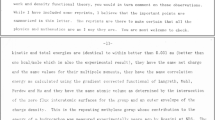Abstract.
A number of fundamental problems with the topological analysis of molecular electron densities using the atoms in molecules (AIM) theory developed by Bader and coworkers are highlighted. In particular, contrary to statements made in the literature, we show that the local zero flux condition used in the AIM theory to define an atom in a molecule does not follow from the Schwinger variation principle, nor does it define unambiguously the atomic domains. Serious limitations of the definition of an atom in AIM theory also arise due to vibrational effects. A general definition of the structure of a molecular isomer based on a generalisation of the Born-Oppenheimer potential energy surface allow these limitations to be overcome.
Similar content being viewed by others
Author information
Authors and Affiliations
Additional information
Received: 9 March 2000 / Accepted: 13 August 2000 / Published online: 21 December 2000
Rights and permissions
About this article
Cite this article
Cassam-Chenaï, P., Jayatilaka, D. Some fundamental problems with zero flux partitioning of electron densities. Theor Chem Acc 105, 213–218 (2001). https://doi.org/10.1007/s002140000201
Issue Date:
DOI: https://doi.org/10.1007/s002140000201




